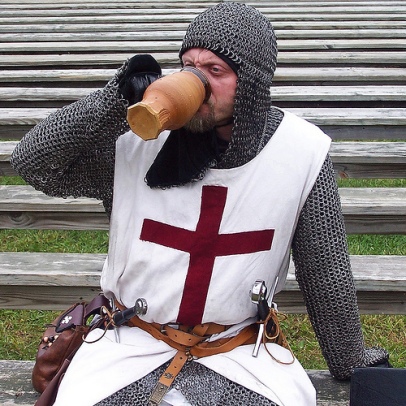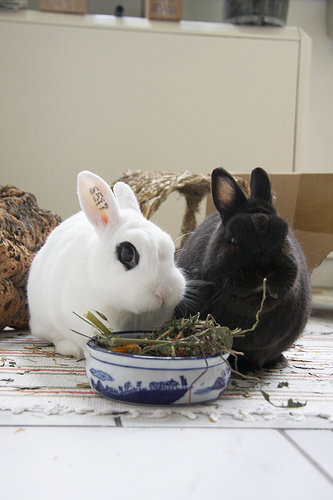‘Bayonet Charge’ is a poem written by Ted Hughes. It is included on the English Literature GCSE syllabus. It depicts the thoughts and feelings of one soldier as he charges at the enemy and begins to question his role in the battle.
‘Bayonet Charge’ by Ted Hughes
Suddenly he awoke and was running – raw
In raw-seamed hot khaki, his sweat heavy,
Stumbling across a field of clods towards a green hedge
That dazzled with rifle fire, hearing
Bullets smacking the belly out of the air –
He lugged a rifle numb as a smashed arm;
The patriotic tear that had brimmed in his eye
Sweating like molten iron from the centre of his chest, –
In bewilderment then he almost stopped –
In what cold clockwork of the stars and the nations
Was he the hand pointing that second? He was running
Like a man who has jumped up in the dark and runs
Listening between his footfalls for the reason
Of his still running, and his foot hung like
Statuary in mid-stride. Then the shot-slashed furrows
Threw up a yellow hare that rolled like a flame
And crawled in a threshing circle, its mouth wide
Open silent, its eyes standing out.
He plunged past with his bayonet toward the green hedge,
King, honour, human dignity, etcetera
Dropped like luxuries in a yelling alarm
To get out of that blue crackling air
His terror’s touchy dynamite.
Tone and Action in ‘Bayonet Charge’
This poem is set in the midst of action as soldiers attempt a bayonet charge during battle. Hughes recreates the feeling on this chaotic moment in several ways.
The poem opens abruptly: ‘Suddenly he awoke and was running’. This is a startling opening, immediately giving the feeling of action and danger. Similarly, Hughes uses dashes to abruptly and unpredictably break up the flow of the sentences.
Enjambment describes the technique of breaking up a sentence so that it runs over more than one line of the poem. There is almost constant enjambment throughout ‘Bayonet Charge’ – sentences even continue over the breaks between stanzas. This constant, uninterrupted flow reflects the fast pace and chaos of the moment.
The Soldier’s Role in War
In the second stanza, the soldier begins to question his role in the conflict. He wonders ‘In what cold clockwork of the stars and the nations / Was he the hand pointing that second?’ The stars and the nations are massive, impersonal, even cosmic forces that decide his fate. They work mechanically and unemotionally like ‘cold clockwork’. The soldier doesn’t feel that he has made a choice to actively participate in war. He is merely a hand on a clock, a cog in the machine, exploited by much larger and more powerful forces.
The poet undermines the usual rhetoric of war – ‘King, honour, human dignity’ – with a dismissive ‘etcetera’. During battle, these concepts ‘drop like luxuries’. For those directly involved in the fighting, belief in these ideals is self-indulgent and irrelevant and must be abandoned to survive. Far from being a necessary motivation, these concepts are hollow and meaningless in the brutal realities of war. Only those not involved in fighting can continue to believe in these grand ideals.

Photo Credit: One lucky guy via Compfight cc
People…and Hares
It is also striking that the soldier is the only person described in the poem. His comrades are not mentioned. This is surprising – a battlefield would in reality be full of people. This sense of isolation makes the moment more intense. The soldier is fighting for his own survival; everything else is irrelevant and no one else can defend him.
Similarly, the only indication of the enemy’s presence is the ‘green hedge / That dazzle[s] with rifle fire’. The enemy is dehumanised and unseen, making them more frightening and unpredictable.
In fact, the only other living being in the poem is the hare – although it might not live for long. The hare is terrified and defenceless, ‘its mouth wide / Open silent, its eyes standing out’. It helplessly ‘roll[s] like a flame / And crawl[s] in a threshing circle’. These circular motions give the impression that the hare is trapped. Both the hare and the soldier are caught up in a deadly situation – in someone else’s battle.

Photo Credit: blumenbiene via Compfight cc
Nice!
LikeLiked by 1 person
Yes! TOTALLY
LikeLike
i think that the hare could have been another soldier, a coward soldier at that. I think this because yellow is not usually the colour of a hare and yellow is also a colour of fear in my opinion. also he could have felt trapped as he was a coward and if he did not go to fight he would have faced definite death by law.
LikeLiked by 1 person
The hare. I agree with the whole idea but not with the hare idea. I would believe it would be a bullet. The hare would symbolise the gun shots, the bullets flying and the red flames was the gun powder coming from the guns. Although it could mean a physical Hare.
LikeLike
Please tell me you do other poems that this was AMAZING
LikeLike
‘Nice’ seems a woefully superficial response to a poem, like those of Wilfred Owen, which portrays the brutish reality of warfare.
LikeLike
i still dont really understand the last paragraph i need the deeper meaning
LikeLike
well done
now i fully understand the poem
i wish u were my English teacher (no offence) 😉 lol
LikeLike
[…] by the teacher. Taking the original article’s reference to Ted Hughes’ poem Bayonet Charge as an example: As a 40+ adult, I intuit just from the title that we are are dealing with a World […]
LikeLike
I interpreted the as a double meaning, the fear of the hare and also gas. They both fit the text.
LikeLike
What attitudes or feelings do you get from this poem?
LikeLike
The hare could also resemble a sign of fertility dying, as Pagans see a golden hare as the symbolism of fertility. This could show how fertility is controlled and trapped by men to fight their battles or how it dies within war.
The way it rolls could also show an infinite loop of war, a cycle that will not break.
LikeLike